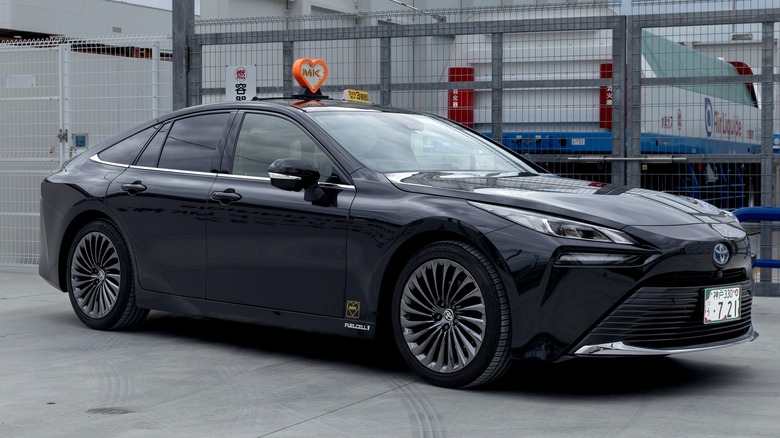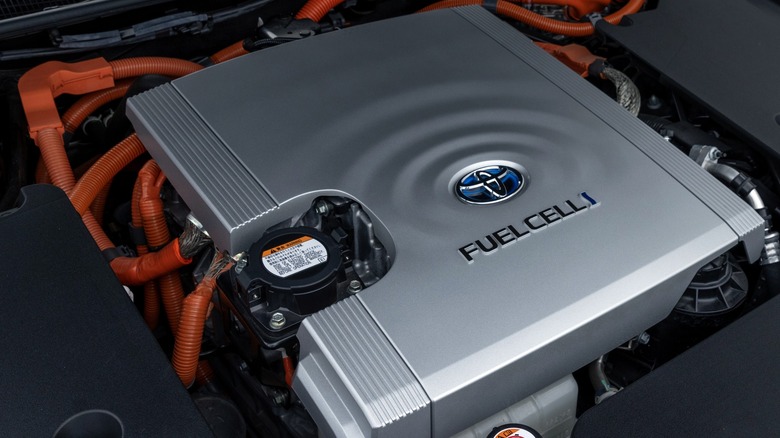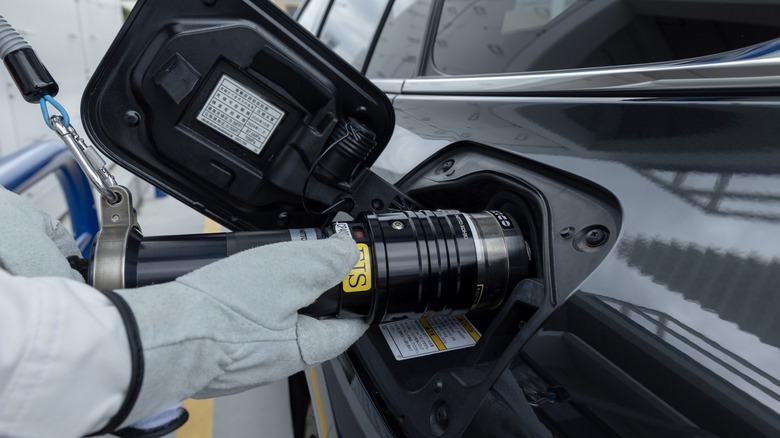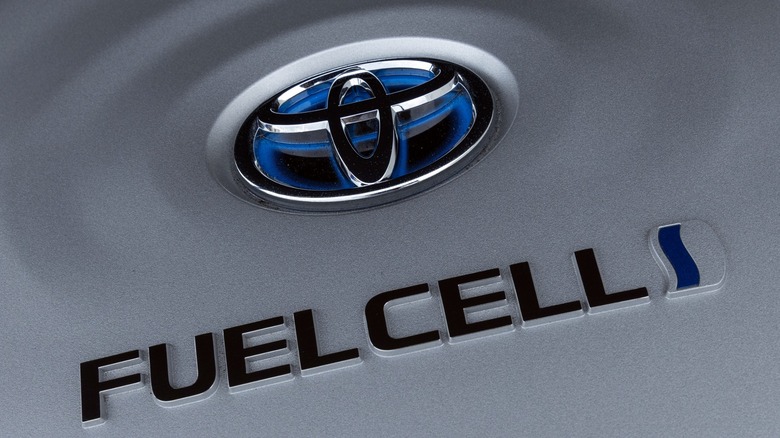Everything To Know About The Hydrogen-Powered Toyota Mirai
When it comes to alternatives to traditional gasoline internal combustion vehicles, the first thing that comes to most folks' minds is full-battery electric vehicles. However, from time to time, in a conversation about alternative fuels and transport, the concept of hydrogen fuel cells will be brought to the table. Most auto-inclined folks are familiar with the concept to some extent. However, some folk may be oblivious to the fact that there is currently a hydrogen-fuel-cell vehicle in production that consumers can buy: the Toyota Mirai.
If you haven't heard of the Toyota Mirai, it's likely because you're in a market that does not offer them for sale. The limited infrastructure for a hydrogen-powered vehicle is a major factor in the Mirai's usability. As of 2023, there are only 59 retail hydrogen stations in the U.S., with the vast majority in California. However, as more infrastructure rolls out, the Mirai may well make its way to the rest of the country. Let's take a look at the specs and info on the Toyota Mirai!
How does the Toyota Mirai work?
Toyota started developing hydrogen fuel-cell vehicles in 1992. More than 20 years later, Toyota released the Mirai for the 2015 model year, making it the first hydrogen fuel-cell vehicle to hit the consumer market. Understandably, some folk are entirely in the dark about how a fuel-cell vehicle works.
In essence, the Mirai is an electric vehicle. However, rather than charging it like you would a standard EV, it has an onboard system of hydrogen tanks and a fuel cell. The compressed hydrogen enters the fuel-cell stack and transforms its chemical energy into electricity, which then powers the Mirai's electric drivetrain. As a result, the vehicle has zero tailpipe emissions, and the only byproduct of this process is water.
Perhaps the biggest advantage of a hydrogen fuel-cell car over a standard EV is the difference in time when it comes to re-fueling vs. recharging. Like a standard internal combustion engine car, filling the Mirai's hydrogen tanks takes only about five minutes to fill. However, the limited number of fueling stations for hydrogen vehicles does add a layer of complexity and inconvenience.
How many miles can a Toyota Mirai go on a full tank?
Toyota says the new Mirai is capable of up to 402 miles of driving range with a full load of hydrogen. The EPA states that it sees up to 76 and 71 miles per gallon equivalent (MPGe) in city and highway driving, respectively.
In addition, if you buy or lease a new Toyota Mirai before April 2024, it comes with a $15,000 gas card that is good for three years when leasing, or six years with a purchase. That's great news for those who are in the market for a Mirai, but it's only great news because of some bad news. In late 2023, the cost of Hydrogen at True Zero, which operates 37 of the 53 fueling stations in California, spiked to a new high of $36 per kilogram. The Mirai has a 5.6kg tank, so it costs around $200 to fill. Effectively, at this price point, the $15,000 in complimentary fuel for the Mirai will net owners around 30,000 miles of driving before they have to start paying out of pocket.
Fuel cell safety and practicality
If you know anything about the history of hydrogen, you'd be forgiven for immediately thinking of the Hindenburg disaster. However, a lot has been learned about the safety of handling combustible materials since that fateful day in 1937.
Toyota says that the Mirai's fuel tanks were rigorously tested for safety. They're carbon-fiber-wrapped and polymer-lined for durability. The result is tanks that can absorb five times the crash energy of steel. In addition, the Mirai has sensors that detect leaks and collisions. So, in the event of a leak, the Mirai automatically seals off the tanks to prevent any further gas from escaping. Effectively, driving a Mirai is no more dangerous than driving a standard internal combustion engine car with a tank full of fuel.
Practicality, on the other hand, is much more of a concern. With the current cost of hydrogen, it's much more affordable to drive a standard internal combustion engine vehicle. With cars like the 2024 Toyota Prius eclipsing 600 miles of range on a single fill, it's hard to justify the additional cost for the gain of zero tailpipe emissions. For an electric comparison, it costs 14 times as much as driving a Tesla in the state of California.
It makes sense, then, that the Mirai's only competitor, the Honda Clarity, was discontinued after the 2021 model year. However, Toyota intends to sell over 200,000 hydrogen vehicles by 2030. Hopefully, an expanded fueling network and cheaper fuel are on the horizon.



